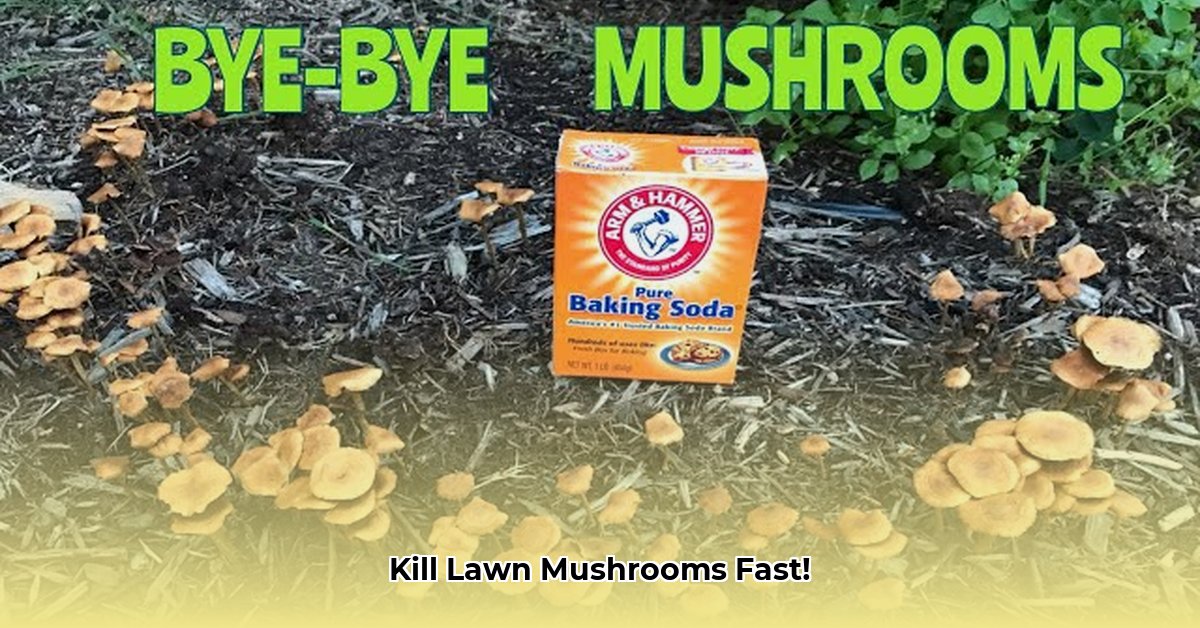Discovering mushrooms sprouting in your lawn is a common experience. While they might seem harmless, their presence often indicates underlying issues that need addressing for a truly healthy lawn. This guide delves into the reasons behind mushroom growth and provides a comprehensive strategy for eradication and long-term prevention.
Decoding Mushroom Growth: Understanding the Underlying Causes
Mushrooms are merely the visible fruiting bodies of a vast underground fungal network (mycelium). This network thrives in damp, shaded environments rich in decaying organic matter like dead grass (thatch), fallen leaves, and other yard debris. A consistently moist or shaded lawn creates the perfect breeding ground for these fungi. Therefore, addressing these root causes is crucial for effective and lasting mushroom control.
A Practical Approach to Mushroom Removal: Step-by-Step
This actionable plan will guide you through eliminating existing mushrooms and preventing their return:
-
Manual Removal and Disposal: Mowing over mushrooms simply spreads their spores, exacerbating the problem. Instead, physically remove them, digging around the base to extract as much of the mycelium as possible. Dispose of the mushrooms in a sealed bag in the trash to prevent spore dispersal in your compost or yard.
-
Optimize Drainage and Aeration: Mushrooms flourish in damp conditions. Aerating your lawn is essential for improving drainage and air circulation. This process involves creating small holes in the soil to alleviate compaction, allowing water to penetrate deeper and preventing surface moisture. For severely compacted soil or low-lying areas prone to water accumulation, consider incorporating a layer of gravel beneath the topsoil to further enhance drainage. This can involve amending heavy clay soils with organic matter like compost to improve its structure and drainage capacity. Installing French drains or extending downspouts can also divert excess water away from susceptible areas.
-
Implement a Smart Watering Strategy: Overwatering creates an ideal environment for mushroom growth. Water deeply but less frequently, encouraging robust root development and minimizing surface moisture. The best time to water is early morning, allowing the grass to dry thoroughly before nightfall, thereby reducing the dampness that mushrooms favor. Consider using a rain gauge or soil moisture meter to monitor water levels and avoid unnecessary irrigation.
-
Regular Dethatching: Thatch, the layer of dead grass accumulating between the soil and living grass blades, traps moisture and provides a rich food source for fungi. Regular dethatching, using a rake, dethatching machine, or even a specialized dethatching blade on your mower, removes this layer, improving air circulation and reducing moisture retention. The frequency of dethatching depends on your grass type and the rate of thatch accumulation. Generally, once a year in the early spring or fall is sufficient for most lawns.
-
Soil Enhancement and Nutrient Management: Healthy soil is naturally more resistant to fungal issues. Aerating and amending your soil with compost enhances soil structure, drainage, and nutrient content. However, avoid excessive compost application, as too much organic matter can inadvertently fuel mushroom growth. Conduct a soil test to determine your lawn’s specific nutrient requirements and apply the appropriate fertilizer accordingly. This targeted approach optimizes nutrient levels without creating an overabundance that could encourage fungal growth.
Long-Term Mushroom Prevention: Maintaining a Healthy Lawn
Eliminating existing mushrooms is only half the battle. Long-term prevention requires a proactive approach:
-
Consistent Aeration and Overseeding: Integrate aeration into your regular lawn care routine, ideally once or twice a year, to maintain optimal drainage and airflow. Overseeding after aeration introduces new grass seed, promoting thicker turf that crowds out fungi.
-
Balanced Fertilization: Base your fertilization schedule on the findings of a soil test. Addressing nutrient deficiencies ensures healthy grass growth without over-fertilizing, which can contribute to fungal problems. Slow-release fertilizers provide a more consistent nutrient supply, minimizing rapid growth spurts that can weaken the turf.
-
Strategic Mulch Application: While mulch offers benefits, avoid excessive buildup near the lawn’s edge, as it can retain moisture and foster mushroom growth. Use a thin layer of mulch, preferably a coarse hardwood variety, and ensure it doesn’t directly contact the grass blades.
-
Regular Lawn Inspections and Prompt Action: Inspect your lawn regularly for any signs of mushroom growth. Early detection allows for immediate intervention, preventing a minor issue from escalating. A quick check every week or two during periods conducive to mushroom growth (e.g., rainy seasons) is recommended.
Seeking Professional Assistance: When to Call an Expert
If DIY methods prove ineffective, or if you encounter unusual or potentially toxic mushrooms, consult a qualified lawn care professional. They can diagnose the cause of persistent mushroom growth, recommend specialized treatments, and address complex drainage or soil issues. They can also identify potentially harmful mushroom species, ensuring the safety of your family and pets.
Mushroom Safety: Protecting Your Loved Ones
While most lawn mushrooms are harmless, some can be toxic. If you have children or pets, promptly remove all mushrooms, regardless of their appearance. If you suspect mushroom poisoning, seek immediate medical attention. Never consume wild mushrooms unless you are an expert in identifying edible species. Prioritizing safety is paramount.
- Call of Duty Not Opening on Steam? Heres How to Fix It - December 29, 2025
- Cod Not Launching? Here Are Quick Fixes to Get Playing - December 28, 2025
- Why Will Call Of Duty Warzone Not Run On Steam Software Or - December 27, 2025

